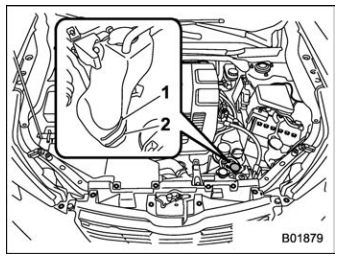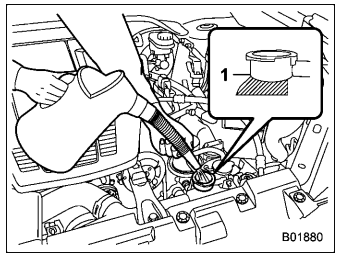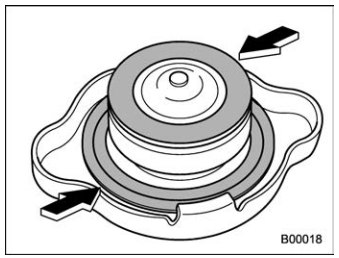Subaru Forester: Cooling system / Engine coolant
Checking the coolant level
WARNING
Never attempt to remove the radiator cap until the engine has been shut off and has cooled down completely. Since the coolant is under pressure, you may suffer serious burns from a spray of boiling hot coolant when the cap is removed.

- “FULL” level mark
- “LOW” level mark
Check the coolant level at each fuel stop.
- Check the coolant level on the outside of the reservoir while the engine is cool.
- If the level is close to or lower than the
“LOW” level mark, add coolant up to the
“FULL” level mark. If the reserve tank is
empty, remove the radiator cap and refill
coolant up to just below the filler neck as
shown in the following illustration.

Fill up to this level.

- After refilling the reserve tank and the radiator, reinstall the cap and check that the rubber gaskets inside the radiator cap are in the proper position.
CAUTION
- Be careful not to spill engine coolant when adding it. If coolant touches the exhaust pipe, it may cause a bad smell, smoke, and/or a fire. If engine coolant gets on the exhaust pipe, be sure to wipe it off.
- Do not splash the engine coolant over painted parts. The alcohol contained in the engine coolant may damage the paint surface.
Changing the coolant
It may be difficult to change the coolant. Have the coolant changed by your SUBARU dealer if necessary.
The coolant should be changed according to the maintenance schedule in the “Warranty and Maintenance Booklet”.
 Air cleaner element
Air cleaner element
WARNING
Do not operate the engine with the
air cleaner element removed. The air
cleaner element not only filters intake
air but also stops flames if the
engine backfires...
Other information:
Subaru Forester 2019-2025 Owners Manual: Examples of the types of accidents in which the SRS curtain airbag will most likely deploy
The vehicle is involved in a severe side impact near the front seat or the rear seat. The vehicle rolls onto its side or the roof. The angle of vehicle tip-up is marginal or the skidding vehicle’s tires hit a curbstone laterally. An offset frontal collision that is severe enough to deploy the front airbag...
Subaru Forester 2019-2025 Owners Manual: Front turn signal light
Right-hand side Use a screwdriver to remove the clips on the air intake duct, then remove the duct. Left-hand side Use a screwdriver to remove the secured clip of the washer tank. To make it easy to access the bulb, turn the neck of the washer fluid filler pipe as illustrated...
Categories
- Manuals Home
- Subaru Forester Owners Manual
- Subaru Forester Service Manual
- Replacing battery of access key fob
- Automatic door locking/unlocking
- Steering Responsive Headlight (SRH)
- New on site
- Most important about car
Outside temperature indicator
The outside temperature is displayed on the multi-function display (color LCD).
NOTE
The outside temperature indicator shows the temperature around the sensor. However, the temperature may not be indicated correctly or the update may be delayed in the following conditions. While parking or driving at low speeds When the outside temperature changes suddenly (example: when going in and out of an underground parking area or when passing through a tunnel) When starting the engine after being parked for a certain period of time The temperature unit cannot be changed.
Copyright © 2025 www.suforester5.com

